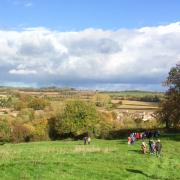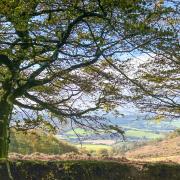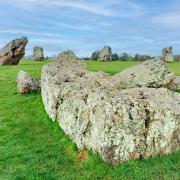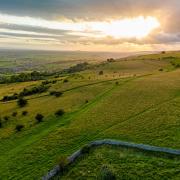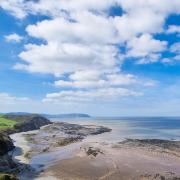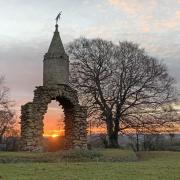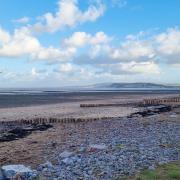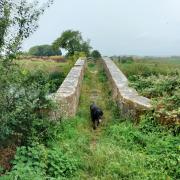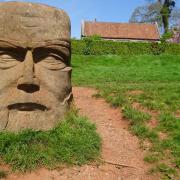Explore the history of the Liberty Trail in Somerset with Simone Stanbrook-Byrne

History and background
Cast your mind back to the second half of the 17th century. England had endured a civil war, a period as a republic and had seen the restoration of the monarchy. Charles ll was on the throne. It was an era of political uncertainty; a time when the religious persuasion of the monarch greatly influenced the mood of the country and occupied the concerns of the population.
The question of who should succeed Charles was a worrying one. None of his legitimate children survived though he had many illegitimate offspring - duplicity was rife: royal religious observation sat alongside regal infidelity.
The boy who was to become the Duke of Monmouth was born in 1649, the eldest illegitimate son of the king and one of his numerous mistresses, Lucy Walters. This boy was fondly acknowledged by his father. A Protestant, he rose to be a politically important figure but ultimately fled to Holland to escape the political turmoil of the early 1680s. On Charles II's death the king's Catholic brother inherited the crown and became James II.

However, within a couple of months of Charles' death Monmouth had his sights re-set on the English throne. He had been a popular figure in England, supported by those who wished to recover the religious and political rights which had been chipped away. Monmouth was encouraged by other exiles and supporters of the Protestant cause, so he returned to the more Protestant-inclined West Country.
Although many men came to support him they were largely ill-equipped, armed with agricultural implements, and they had insufficient strength. King James soon heard of Monmouth's landing at Lyme Regis; the rebels' only chance was to raise forces as they marched.
The Monmouth Rebellion was not to succeed. In spite of his efforts he was eventually captured in Hampshire. His appeals to King James failed and Monmouth was executed on 15 July 1685.
The Liberty Trail follows in the footsteps of some of the villagers who, wearing green sprigs tucked into their hats, marched to Lyme Regis to join forces with Monmouth in that fateful year, their battle cry: "Liberty to the people of God!"

The Route in Somerset
At around 28 miles in length, the Liberty Trail is quite short for a long-distance footpath, but is nonetheless appealing with lots of history to encounter en route. It starts from the Iron Age hill fort at Ham Hill Country Park, high above the village of Stoke-sub-Hamdon in South Somerset, and wends its way to Lyme Regis on the Dorset coast.
Ham Hill is one of Europe's largest Iron Age hill forts, extending to more than 200 acres. It has an impressive history through many ages. Iron Age occupation was extensive, with buildings, fields and a flourishing settlement. Such hill forts developed on naturally-occurring high ground as places to live and trade as they were sites that would be reasonably easy to defend, should the need arise.
Ham Hill's height is an undoubted asset; the views from its war memorial are thirst-quenching. Quarrying of the mellow, honey-coloured ham stone has taken place for centuries in the area and just below the war memorial a recent millennium 'henge' was constructed, commemorating the heritage of local quarrying and quarrymen.
It is also home of the Prince of Wales pub, an excellent, dog and walker-friendly establishment which offers open fires in winter and comforting mulled cider.
The Liberty Trail sets off from the hill heading south and then west to Norton-sub-Hamdon. It winds its way through a hilly landscape until it arrives in West Chinnock, birthplace of cricketer Vic Marks and home of the Muddled Man Inn.
From here the Trail continues south, crossing the A30 and then sliding east into the delightfully-named Haselbury Plucknett, named for hazel trees and the one-time medieval landowners. The village boasts a welcoming 17th century coaching inn, the White Horse, renowned for its food.
From Haselbury Plucknett the path goes south, passing just west of North Perrott then heading south and west to Misterton, a village that was originally called 'Minsterton' meaning 'enclosure around the church', a reminder of the village's historic roots. The Trail hops over the railway line near the mainline Crewkerne Station, situated in Misterton, which links the West Country to London. The Globe Inn offers refreshment.
The Liberty Trail now continues its westward trend to the village of Wayford with its Grade 1 Listed Elizabethan manor house. Although the house is not open to the public the beautiful gardens are open from time to time under the 'Yellow Book' National Garden Scheme.
Beyond here the way continues to Winsham further west, an historic village with its toes in Saxon times but still plenty going on in the modern day. Its parish church was remodelled in the 15th century with local wealth gained from the wool trade.
From here it is about a mile to venerable Forde Abbey. This is another place at which a pause is recommended; the gardens are open all year round, the house from March to October. And it is quite a house: from monastic roots in 1141, it was damaged during the Dissolution of the Monasteries and its stone was subsequently plundered. It saw various changes of ownership and is now a family home. It is known for its 17th century tapestries.
The tapestries were made for the house and have been here several centuries, originally ordered by a former owner, Edmund Prideaux. However, his son, another Edmund, was perceived to be a supporter of the Duke of Monmouth so the tapestries were confiscated and kept in Whitehall until they were returned to Francis Gwyn, Edmund's son-in-law, by Queen Anne in recognition of his work as Secretary of State for War.
Forde Abbey and its glorious gardens sits on the Somerset-Dorset border (the house is actually in Dorset but it has a Somerset address) and it is here that the Liberty Trail hops over the county boundary to continue the rest of its journey to the coast at Lyme Regis.
walking tips
The Liberty Trail links the Leland Trail to the South West Coast Path, so the energetic could extend the walk. It also, at times, runs concurrently with the Monarch's Way.
Although this is a relatively short long-distance path, and at the risk if stating the obvious, it is important to plan ahead thoroughly for what you will need: decent boots, wet weather gear, sun block, first aid, food and water supplies, phone etc.
The whole route could be covered in a couple of days, but a more leisurely pace permits the chance to savour the countryside and explore the sites en route. If you are planning on walking the whole stretch in one go the Liberty Trail passes through some villages where B&Bs can be found - but book ahead.
Maps can be viewed on a smart phone but this method makes it hard to see the wider picture as far as the onward route and surrounding landscape are concerned. I feel you can't beat a 'proper' map, either the laminated versions that are readily available, or paper maps tucked inside a transparent map pocket.
OS Maps that cover the route are Explorer 1:25 000, numbers: 116 (Lyme Regis and Bridport) and 129 (Yeovil & Sherborne).
Useful website: discoversouthsomerset.com/media/971338/liberty_trail




